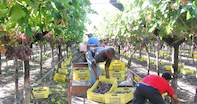Before harvesting it is important to set up a harvesting plan. This harvesting plan will include the expected harvest (in tonnes), estimated harvest date, amount of workers needed, rental of equipment and cost of transport of grapes to the wine cellar.

There must also be made provision to limit oxidation of the grapes during transport, reduce bruising and to ensure safety and hygiene standards.
Equipment needed for wine grape harvesting can include: Tractors or trucks with grape bins Harvesting crates and shears for each worker Clip cards (these cards are punched to determine the number of crates picked per worker) Mobile toilet and drinking water First aid kit with plasters and disinfectant Refractometer for regular testing of sugar levels in harvested grapes.
Hand Harvesting of Wine Grapes

Ripe bunches are cut with a harvesting shear and placed into the harvesting crates. These crates are usually positioned under or near the vine. When the crate is full, it is emptied into the harvesting bin on the tractor or truck. Grape bins are large plastic or steel containers with a capacity of 5-6 ton but loads are kept small to reduce bruising and the formation of juice and possible oxidation of the juice.
Some producers prefer to transport the crates to the cellar to reduce bruising and loss of juice. Grapes must be transported to the cellar as soon as possible and not left standing in the sun or heat. If so, juice might start fermenting.
Potassium metabisulfite (K₂S₂O₅) can be added to white grape cultivars to reduce oxidation and prevent early fermentation. (Fermentation is when the juice reacts to wild yeasts to form carbon dioxide and alcohol.
Fermentation should be controlled by adding specific yeasts after the grape juice have been extracted, cooled and are placed in the tanks.) When grapes arrive at the cellar, the bunches are inspected on a conveyor belt and leaves, stems and rotten grapes are removed before the bunches are placed inside the grape press to extract the juice.
Mechanical Harvesting of Wine Grapes
A harvester can be used to harvest wine grapes mechanically. This is done at specially adapted (higher) trellis systems and is often used for high yielding harvests. Bunches are removed from the vines by moving rods and the berries collected into the harvest bin on the machine while the leaves are removed by high-pressure air.
The main advantage of mechanical harvesting is speed – grapes are delivered to the cellar much faster than with hand harvesting. Large areas of vineyards can be harvested in a day, less labour is required and harvesting can be done during the cool hours of the day.
This is especially important to ensure quality and reduce oxidation of grapes. Disadvantages of mechanical harvesting include possible damage to grape shoots (stems) and that sick or unripe bunches are harvested together with healthy ones.
By Vinpro